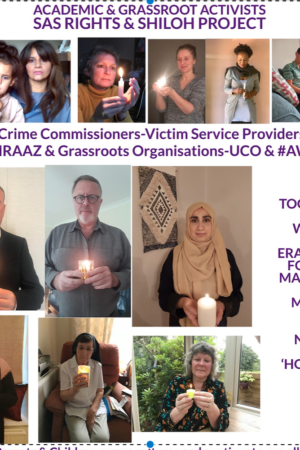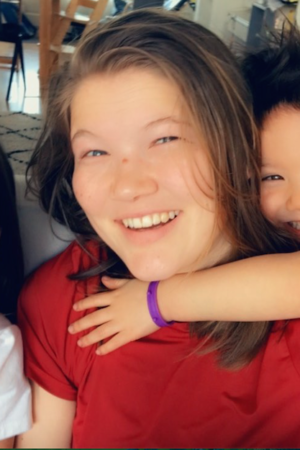Today’s post is by Simon Phillips. Simon is a Community Engagement Officer for West Yorkshire Police and the Director of Interfaith for the Leeds Jewish Representative Council.
Much of the public discourse of ‘violence’ on the one hand and ‘Jews’ or ‘Judaism’ on the other, focuses on anti-Semitic violence. The gender-based forms of anti-Semitic violence have featured previously in a Shiloh post by Miryam Sivan (see here).
This post, however, looks instead at domestic violence within Jewish communities and at how men and boys can be and are engaged in resisting and bringing an end to gender-based violence.
Simon is actively involved in the White Ribbon Campaign. Please read and get your ribbons ready for 25 November.
______________________________________________________________________
The White Ribbon Campaign is an increasingly popular campaign to encourage men and boys to take a stand against domestic violence. The Campaign was founded in 2007 and works with men and boys to challenge those male cultures that lead to harassment, abuse and violence.
Some of these cultures incorporate elements of religion and belief, because understandings of domestic violence – including physical, sexual, financial and emotional violence – are influenced, too, by biblical and other scriptural sources. Some examples from Judaism are cited below.
Volunteer ‘ambassadors’ of the Campaign engage with other men and boys towards eliminating domestic violence and to promote, instead, a culture of equality and respect. Men and boys wear white ribbons as a symbol of engagement in the endeavour to end violence against women and girls. This is particularly visible on 25th November, the UN Day for the Elimination of Violence Against Women.
Interesting, including from a faith perspective, is that the white ribbon was since its foundation in 1873, the badge of the Woman’s Christian Temperance Union. The white ribbon was initially selected to symbolize purity. But in this Campaign the white ribbon is a symbol for anti-violence against women, as well as for safe motherhood, and related causes.
We know that whilst anyone can be at risk of domestic violence, irrespective of cultural or religious background, some forms of violence against women and girls are very much rooted in culture or religion. This includes Female Genital Mutilation (FGM), Forced Marriage and Honour-Based Abuse (for a Shiloh post on forced marriage and honour-based violence, see here).
An estimated 66,000 women living in England and Wales have been subject to FGM. Meanwhile, in 2017 alone, the Forced Marriage Unit gave advice or support related to a possible forced marriage in 1,196 cases. 73% involved female victims. The oldest victim was 100 and the youngest a mere 2 years old.
In my capacity as White Ribbon Ambassador, I am currently co-ordinating a project with the Leeds Jewish community. This project is funded by the Police and Crime Commissioner’s Safer Communities Fund and is aimed at raising awareness of the Campaign, through engaging with a range of community organisations across the Jewish religious spectrum.
The project is entitled Shalom Bayit, which is Hebrew and means ‘Peaceful Home’ or ‘Peace in the Home’. The project aims to empower Jewish men and boys to stand up against domestic violence. The term sh’lom beto (Hebrew for ‘peace of his home’) is found in the Talmud and refers to domestic peace in general. Nowadays, it is mostly used with reference to matrimonial peace. Shalom bayit signifies completeness, wholeness, and fulfillment. Hence, traditionally, the ideal Jewish marriage is characterized by peace, nurturing, respect, and chesed (roughly meaning ‘kindness’, or ‘loving-kindness’), through which a married couple becomes complete. It is believed that God’s presence dwells in a pure and loving home. I return to Jewish perspectives on violence in due course.
There are various reasons why abuse might be prevalent in faith communities and these reasons coexist with wider societal beliefs, perceptions and stereotypes about male roles and character traits – such as the stereotype of the man as head of the family who is strong, powerful, a leader, competitive and authoritarian.
Some of these attitudes and behaviours are reinforced by religious doctrines and have sometimes had devastating consequences, particularly for women and girls. This has led some police forces to consider the introduction of misogyny as a separate strand of hate crime. Faith communities (and I am not confining myself here to Jewish communities) are sometimes characterized by:
- attitudes that have potentially damaging impact for reporting abuse within the family or community, e.g. izzat (‘honour’)and sharam (‘shame’, compare Hebrew bushah), and which can lead to social exclusion or victimization;
- powerful religious/community leaders of ‘closed’ communities who may not always respond in supportive ways to disclosures of abuse, or who put pressure on those in abusive marriages not to leave the marriage (e.g. because marriage is perceived as a divine covenant, or as being for life);
- scriptures that lend themselves to justifying abusive or controlling behaviour, or to resisting separation/divorce even when a marriage is violent;
- viewing a degree of violence as ‘acceptable’ or ‘normal’ in some circumstances or settings;
- a lack of access to accommodation which provides for cultural/religious needs
- difficulties pertaining to language or literacy, as well as to immigration status or financial resources.
Let me focus again on Judaism. Ironically, Judaism’s emphasis on family life and family values can be the very thing that makes it difficult for women suffering domestic abuse to come forward and ask for help. All too often, Jewish women may remain silent in the face of abuse on account of shame, embarrassment, a feeling of guilt, or of fear that they will not be believed. They may feel alone, that no-one else has experienced what they have and that, somehow, the abuse must be their fault.
Research undertaken and information disseminated in the last ten years by the dedicated service Jewish Women’s Aid, highlights the scale of the problem and the need for a cross-communal response in dealing with this complex issue.
The 2011 research, ‘You know a Jewish woman experiencing domestic abuse: Domestic abuse in the British Jewish Community’, reveals the following:
- 68% of the British Jewish Community believe that abuse happens at the same rate in the Jewish community as in British society at large
- 62% were not aware of a communal Rabbi publicly addressing the issue but where a Rabbi had, 88% had condemned abuse
- Synagogues, communal organisations and leaders should do more to educate on the topic of domestic abuse
- Young women need financial awareness training and post-pregnancy support
- Jewish experiences should be understood in the context of other Black-Minority Ethnic (BME) community experiences.
Looking back at Jewish Scriptures, acts of sexual assault and abuse against women are regularly viewed in terms of violating male property rights (e.g. Deuteronomy 22:29). The husband is sometimes termed ba’al (‘master’), implying ownership and lordship. If a wife is physically harmed by someone, compensation is paid to her husband (e.g. Exodus 21:22). In the Mishnah and Talmud, too, there is no discussion of wife-beating as a distinct category of violence. Yet there is discussion around immodest behaviour considered worthy of punishment, which includes ‘going out with uncovered head, spinning wool with uncovered arms in the street, [and] conversing with every man’.
Responsa literature, which includes rabbinic rulings, including on domestic abuse (7th-10th century C.E.), sees some declaring wife-beating unlawful, while others justify it under certain circumstances. Striking a wife without a reason is forbidden by all. However, violence against ‘bad wives’ is justified if it is for ‘educational’ purposes, or if a wife is not performing the duties required of her by Jewish law, or if she behaves immodestly, or curses her parents, husband, or in-laws.
Moving next to Jewish medieval attitudes in the Muslim World, Rabbi Yehudai b. Nahman (Yehudai Gaon, 757–761) writes that: ‘…when her husband enters the house, [a wife] must rise and cannot sit down until he sits, and she should never raise her voice against her husband. Even if he hits her she has to remain silent, because that is how chaste women behave’ (Otzar ha-Ge’onim, Ketubbot 169–170). Moses Maimonides (1135–1204) recommends beating a ‘bad wife’ as an acceptable form of discipline: ‘A wife who refuses to perform any kind of work that she is obligated to do, may be compelled to perform it, even by scourging her with a rod’ (Ishut 21:10).
In medieval Europe, attitudes in Jewish writings tend to reflect a Jewish society in which women held comparatively high social and economic status and many writings reject wife-beating without any qualification. Rabbi Peretz b. Elijah, for instance, writes: ‘one who beats his wife is in the same category as one who beats a stranger’. Some Rabbis considered violence as grounds for forcing a man to give a get (that is, a divorce agreement). Rabbi Simhah argued that like Eve, ‘the mother of all living’ (Genesis 3:20), a wife is given to a man for living, not for suffering.
Sixteenth century views acknowledge that wife-beating is wrong, yet tend to avoid releasing a woman from a bad marriage and Halakhah (Jewish law) is based on husbands’ dominant position in marriage. In more modern times, too, domestic abuse is not automatic grounds for Jewish divorce. An abused woman whose husband refuses to give her a divorce is considered an agunah, a chained or anchored woman.
The depiction of domestic abuse in Jewish sources through time is, therefore, mixed and sometimes ambiguous.
The stimulus for my current community project is the partnership between, on the one hand, the Leeds City Council’s Domestic Violence Unit and, on the other, a range of Leeds faith communities. This partnership encourages religious and lay leaders, as well as other members of faith communities, to engage with the White Ribbon Campaign. One way to do this is through posting ‘selfies’ to make participants’ support visible and public.
Last year in November I organised a roadshow at the Marjorie and Arnold Ziff Community Centre in Leeds to mark the International Day for the Elimination of Violence Against Women. Along with members of Jewish and other faiths, I sourced quotations from many sacred scriptures to demonstrate that in accordance with portions of sacred text abuse against women and girls isn’t justified or legitimate. Acknowledging, as illustrated above, that in Judaism certainly, scope for ambiguity exists, it is these passages the Campaign seeks to highlight.
Here are some examples:
The project seeks to demonstrate that a community-wide response can publicize and challenge domestic violence, alongside informing and empowering those who stand up to it. Shalom Bayit, maintaining peace and harmony in the home, is often seen as primarily a female responsibility, when it needs to be everyone’s responsibility.
Jewish Women’s Aid does a fantastic job in helping hundreds of women locally and nationally whose lives have been blighted by domestic abuse. But more needs to be done in terms of preventative (rather than just reactive) measures if we are to break the vicious cycle. One way of doing that, I believe, is to engage with men and boys inside the community.
The project is aligned with wider campaigns on domestic abuse led by both Jewish Women’s Aid and the West Yorkshire Police. The funding we’ve secured from the Police and Crime Commissioner’s Safer Communities Fund will go some way towards enabling us to deliver the next phase of the project to a much wider audience over an extended period of time, and in doing so, we will have a much greater impact on both preventing and addressing the key issues surrounding domestic abuse against women and girls.
I would welcome your participation and involvement.
For further information, please contact me at either interfaithljrc@outlook.com, or simon.phillips@westyorkshire.pnn.police.uk














